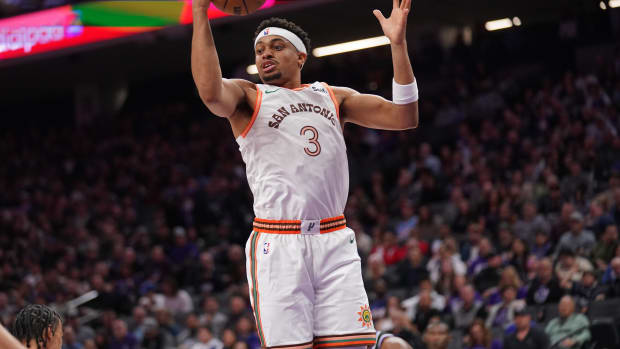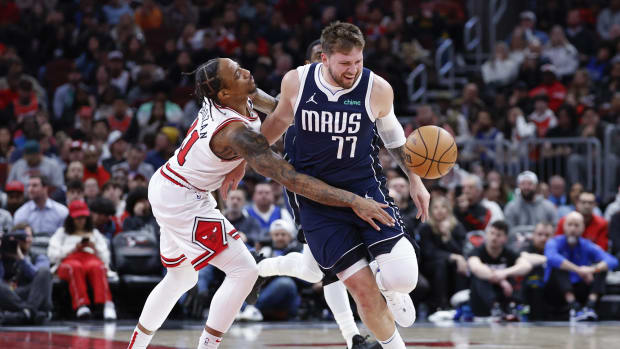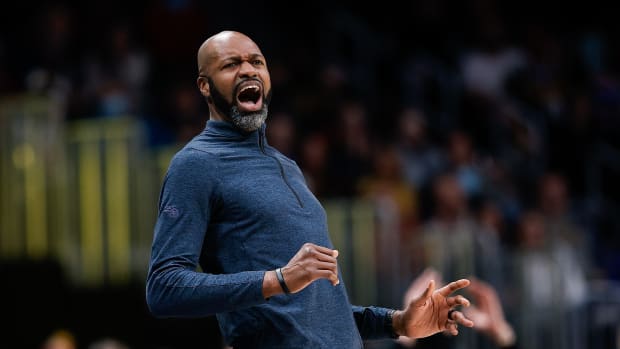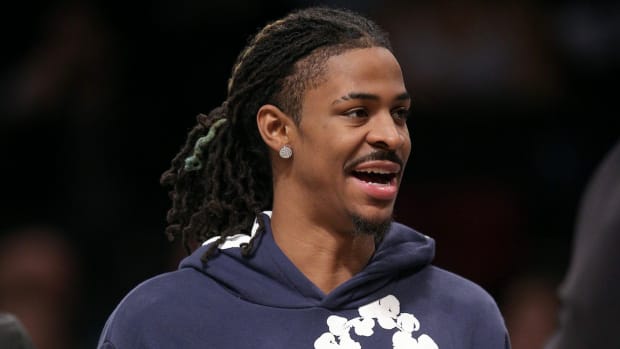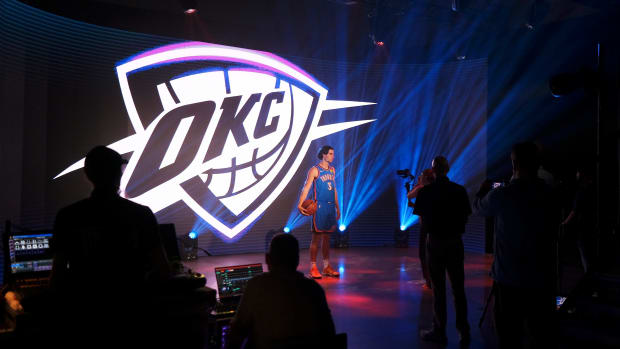Life among the trees: Harrison Barnes on the Warriors' small-ball defense
A couple weeks ago, when Harrison Barnes shadowed Zach Randolph in Game 4 of the Grizzlies-Warriors series, the Memphis big man was confused. He looked around, did some mental math.
“Who are you guarding?” Randolph finally asked.
“You,” Barnes said.
“Seriously?” Randolph asked.
Barnes smiles at the memory. “He was shocked because it’s like, ‘If you’re guarding me then somebody else should be wide open.’ But then he can’t find that guy.’”
One can understand Randolph’s confusion. Here he was, one of the best low-post players in the league, being guarded by a wiry wing ceding maybe 50 pounds.
Offended, Randolph set to work, going at Barnes while narrating the action. “Z-Bo is probably the only person I’ve ever met who talks trash to you while he’s shooting the ball,” says Barnes. “He kept saying, ‘C’mere little fella!’ and ‘Hold this, little fella!’ And he’d say it as he was shooting a jump hook.”
Regardless, the Warriors’ gambit worked—in this case with Andrew Bogut playing a roving help defense role—just as the team’s unconventional defensive schemes have so often this season.
Sometimes, the 6’8” Barnes is the tallest player on the court, with 6’7” Draymond Green playing center. Sometimes all five players switch on pick-and-rolls. Sometimes they play Bogut alongside a bunch of skinny perimeter specialists. The Warriors will go small against small units but also against big ones, as they did in Game 2 against Houston, when Green guarded Dwight Howard straight up for stretches.
• MORE NBA: SI cover story: Steph Curry's next stage could be the Finals
Of course, the Warriors are uniquely equipped to pull off these schemes, stocked with a bevy of long, smart defenders and a rim protector, Bogut, who cleans up a lot of mistakes when he’s in the game. Even so, the system only works if the wings can do a credible job of holding their own in the paint, both straight up and on switches. It’s not something players like Barnes ever anticipated doing in the NBA. After all, what small forward expects to guard Marc Gasol or Z-Bo?
In Barnes’ case, the team chose him for a reason. Warriors assistant coach Luke Walton, who is 6’8” and maybe 250 or so these days, often works with players in the post during and after practices, banging and bumping away. All the while, he’s gauging who possesses Skinny Guy Strength and who doesn’t. “There are only so many wings that can guard the post,” says Walton. “You have to be very strong.”
As Game 3 showed, Rockets need a better Harden against Warriors, Curry
Over the years, Walton has been surprised at who qualifies. Trevor Ariza, for example. “When I first played with Trevor in L.A. he looked skinny so I thought I’d get him down there early. But he’s got that wiry strength so I was like, ‘OK, I got to change my game plan.’ As opposed to other guys, you hit them once and you can feel them, a little light.” Another player on the Lakers surprised him as well. “I remember the first time I tried to post Derek Fisher up, he almost broke my back. I was like ‘OK, I’m going to leave Fish alone.’”
From the start, the Warriors staff realized Barnes was one of those guys. “He’s not only very strong, to the core strong, but he’s very quick,” says Walton. “So he can use that to his advantage too. We feel like big guys battling against Harrison, as strong as he is, isn’t as much of an advantage as them trying to guard Harrison on the other end with how quick he is and shooting from the outside.”
• MORE NBA: SI's 10 best Stephen Curry stories | SI's NBA magazine feature
Ron Adams, the Warriors’ defensive guru, agrees. “He likes guarding people in the post,” says Adams, who foresees a league full of Harrison Barnes’ in the future. “I think the way our game is progressing it’s going to be demanded of a lot of people,” he says. For now, Barnes provides a glimpse of that future. “He’s a very versatile defender and his fundamentals are solid. He’s up for the challenge.”
Being up for the challenge is one thing; knowing what to do is another. Earlier this season, the Warriors decided to test Barnes. During a January home game against the Pacers, they put him on Indiana’s reserve bigs, Luis Scola and Lavoy Allen, for stretches. It did not go well. Barnes says he got ducked in repeatedly, and Allen finished with 12 points and nine rebounds on 5-of-6 shooting. “Coach and I talked after the game and broke it down,” says Barnes. “He said you need to get better at this in case we try it in the playoffs.”
In the months that followed, Barnes worked at it. There was no formal training, but watch him and Green now, banging against Howard and other bigs, and certain strategies stand out.
First off, as Adams preaches incessantly, do your work early. Wait until a big man has the ball and you’re toast. “If someone like Z-Bo gets the ball in the middle of the paint, there’s not much you can do,” explains Barnes. “If Conley and Gasol are running a weakside pick, and you’re guarding Z-Bo on this side, you know he’s going to duck in. So you have to be prepared. Maybe you front, workaround to a three-fourths, then get behind him, force him to his right hand. It’s the little things that can save you.” Barnes pauses. “Because if it’s a Josh Smith and Dwight Howard screen and I switch on Dwight and get lazy and sit there and Dwight seals in, I can’t meet him at the rim and he gets a dunk.”
Stephen Curry carries still-evolving Warriors in Game 3 rout of Rockets
Once the big gets the ball, the goal is to make him uncomfortable. “A lot of times guys that aren’t used to guarding in the post will try to lean all their weight into somebody that’s bigger, and use an arm bar and a hand, but they don’t really understand the angles,” explains Walton.
Instead, Walton counsels getting your chest into the bigger man. “When I see him start to go, instead of of letting him make the contact, I want to hit him with my chest.”
Next, don’t try to play a big the way bigs do. “It’s like posting up a small forward instead of a point guard,” says Barnes. “As soon as I face up against a point guard he’s going to eat that space up, be a nuisance. As soon as I put the ball on the floor, he’s going to try to reach, to try to steal. A guy like Dwight, I’m not going to sit there and try to say, ‘OK, I’m going to stand you up right here.’” Instead, Barnes says he’ll try to reach, dig and “speed him up a bit,” make him do something he’s not accustomed to doing.
There are other important concepts: Do your homework, learn tendencies, push the big toward the help. Then there is the unique psychology of the situation—call it “Mouse in the House” impatience. “When a big has a little on him, he’s going to want the ball no matter what,” says Walton. “He’ll be willing to take him another four feet out instead of have the ball go somewhere else.” Indeed, merely the perception of a juicy matchup can alter a team’s entire offensive flow.
But, as Memphis found out, just because something looks like a mismatch, it doesn’t mean it is.






























